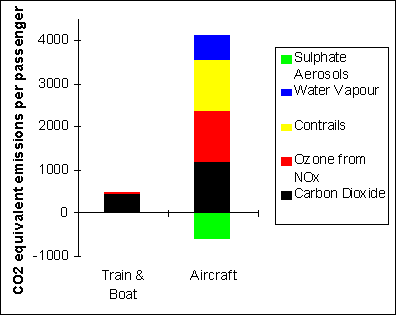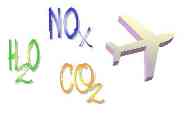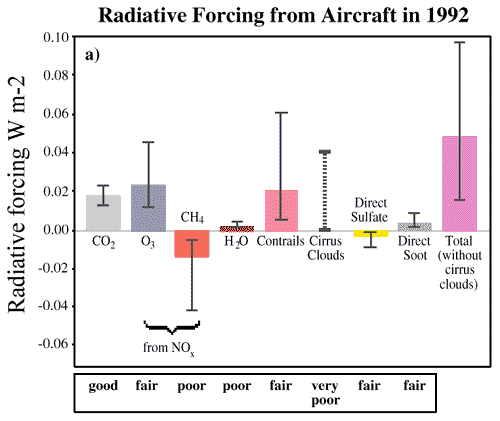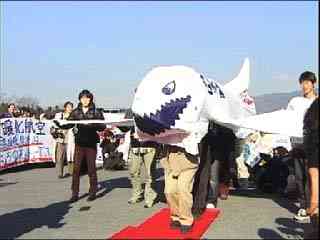
 Into the Sky
Into the Sky
 The most obvious is the water vapour (created by
burning jet fuels -see below) which forms condensation trails -clouds
of frozen ice crystals. Since the air in the upper troposphere (the level at
which most commerical planes fly) is naturally very dry, water vapour emitted
by aircraft can make a big difference. Sometimes the contrails cover the
whole sky as shown by this satellite photo taken over Germany, and the average coverage in this region is about 6%.
Have you ever wondered, why the sky is so much clearer in remoter locations?
The most obvious is the water vapour (created by
burning jet fuels -see below) which forms condensation trails -clouds
of frozen ice crystals. Since the air in the upper troposphere (the level at
which most commerical planes fly) is naturally very dry, water vapour emitted
by aircraft can make a big difference. Sometimes the contrails cover the
whole sky as shown by this satellite photo taken over Germany, and the average coverage in this region is about 6%.
Have you ever wondered, why the sky is so much clearer in remoter locations?
Although these contrails reflect a little sunlight away from earth, they reflect back to earth much more invisible infra-red (heat) radiation which would otherwise escape to space -and therefore they have an overall warming effect. This is hard to measure accurately, because the contrails eventually spread out and become indistinguishable from natural cirrus clouds.
Not all of the water vapour forms contrails, but water is itself a "greenhouse gas" which also traps this outgoing infra-red radiation. Each water molecule traps much more heat and also survives much longer at this height than it would do at sea-level.
Jet-fuel - kerosene - is a mixture of
substances produced by distilling crude oil, which can be represented by
C13H28 (this is assumed in the "how much" calculations"). The chemical equation for
burning it is as follows:
2C13H28 + 40O2
=>26CO2 + 28H2O
So you can see, that for every 14 water molecules produced, the aircraft must also emit 13 of CO2. This is also a greenhouse gas and will stay in the atmosphere warming the earth for an average of 100 years, some of it for 1000s of years. There's no way that you can get the energy from such fossil fuel without producing that much CO2. It's not a by-product that can be "scrubbed" from the exhaust.
A Boeing-747 can burn over 200 tons of fuel in one
flight. If you have already clicked your travel route on the world map, the "how much is this" section will
calculate the volume of CO2 that will be emitted per passenger. The "global context" section compares this
amount to the sustainable average level of emissions per person per year.
If you understand German, you can find a similar calculation on the web page
Klimabelastung durch Flugverkehr
(For more about greenhouse warming click
here)
A simple "rule of thumb" to remember, is that a plane
uses about as much fuel, and therefore produces about as much CO2, as would
every passenger driving one car the same distance. So next time you're
thinking of flying thousands of miles, think how much petrol you would need to
put in a car to go so far. Since take-off uses a disproportionate amount of
fuel, short-haul flights emit a bit more per passenger-kilometer, and
long-haul flights a bit less.
Note: the car comparison is for typical
european cars, not for the less efficient american gas-guzzlers. Trains
produce, on the other hand, about 1/3rd as much CO2 per passenger-kilometer
(for more details on this see the "ecobalance of the Climate Train" and the
bar-chart below), and could potentially be run from renewable sources of
electricity.
So if they use so much fuel, why are flights so cheap now? One reason is that not a penny of tax is paid on aircraft fuel.
But fuel use is not the end of the story. Aircraft also emit NOx gases, a product of combustion of atmospheric nitrogen and oxygen in the very hot jet engines. NOx is not in itself a greenhouse gas but it catalyses the production of ozone (O3), which is a powerful greenhouse gas. Nearer the ground, ozone also leads to the formation of photochemical smog which is harmful to human health.
In the stratosphere, on the other hand, ozone is valuable as it blocks harmful ultra-violet radiation. Unfortunately NOx emissions from aircraft which venture into the stratosphere (such as concorde) catalyse the destruction of ozone there. Confused? -Yes, ozone chemistry is complicated, but in a nutshell, NOx emissions are bad news -producing ozone where we don't want it, and destroying it where we do..
To make matters even more complicated, NOx emissions also catalyse the destruction of methane (CH4), another greenhouse gas, although this cooling effect is much smaller than the ozone warming effect (see IPCC graphic below). Aircraft emissions of sulphate aerosols also have a slight cooling effect, but also contribute to acid rain.
It's not easy to quantify the exact greenhouse warming due to water vapour and NOx emissions from aircraft, but a scientific consensus is now emerging, that the total warming effect of all emissions (CO2, H2O and NOx) put together, is in the range 2-5 times greater than that of CO2 alone. This range was confirmed by analysis in the "Special Report on Aviation" published by the "Intergovernmental Panel on Climate Change" (IPCC) in April 1999.

Only the emissions from the aircraft itself are included here. The processes of refining and transporting the fuel also use energy and would add about 8% to the total CO2 emissions (but not NOx or H2O) . Building and maintaining airports and aircraft also uses a substantial amount of energy which is not considered here.
This image (right) shows the CO2 equivalent warming effect for a journey from Frankfurt to Kyoto both by train (left) and by plane (right) -the different colors correspond to effects of different gases. For more details see the "Ecobalance of the Climate Train"
In my own city, Norwich, England, both a group of local residents, and the Norwich Green Party are campaigning against expansion of our airport.
Below are two pictures taken outside the UN Climate Convention COP3 in Kyoto. The placards indicate cities whose residents are campaigning against the expansion of airports. More info is in the "Climate Train" report.

